
Alfred Elton van Vogt was a Canadian-born American science fiction author. His fragmented, bizarre narrative style influenced later science fiction writers, notably Philip K. Dick. He was one of the most popular and influential practitioners of science fiction in the mid-twentieth century, the genre's so-called Golden Age, and one of the most complex. The Science Fiction Writers of America named him their 14th Grand Master in 1995.

Laurence van Cott Niven is an American science fiction writer. His best-known works are Ringworld (1970), which received Hugo, Locus, Ditmar, and Nebula awards, and, with Jerry Pournelle, The Mote in God's Eye (1974) and Lucifer's Hammer (1977). The Science Fiction and Fantasy Writers of America named him the 2015 recipient of the Damon Knight Memorial Grand Master Award. His work is primarily hard science fiction, using big science concepts and theoretical physics. It also often includes elements of detective fiction and adventure stories. His fantasy includes the series The Magic Goes Away, works of rational fantasy dealing with magic as a non-renewable resource.
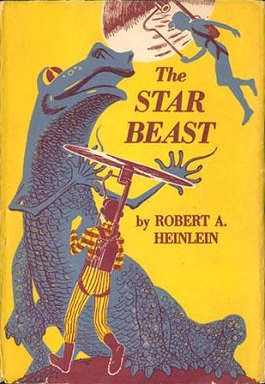
The Star Beast is a 1954 science fiction novel by Robert A. Heinlein about a high school senior who discovers that his extraterrestrial pet is more than it appears to be. The novel was originally serialised, somewhat abridged, in The Magazine of Fantasy & Science Fiction as Star Lummox and then published in hardcover as part of Scribner's series of Heinlein juveniles.

Damon Francis Knight was an American science fiction author, editor, and critic. He is the author of "To Serve Man", a 1950 short story adapted for The Twilight Zone. He was married to fellow writer Kate Wilhelm.

Edmund Alexander Emshwiller was an American visual artist notable for his science fiction illustrations and his pioneering experimental films. He usually signed his illustrations as Emsh but sometimes used Ed Emsh, Ed Emsler, Willer and others.

Lester del Rey was an American science fiction author and editor. He was the author of many books in the juvenile Winston Science Fiction series, and the editor at Del Rey Books, the fantasy and science fiction imprint of Ballantine Books, along with his fourth wife Judy-Lynn del Rey.

Joe William Haldeman is an American science fiction author. He is best known for his novel The Forever War (1974). That novel and other works, including The Hemingway Hoax (1991) and Forever Peace (1997), have won science fiction awards, including the Hugo Award and Nebula Award. He was awarded the SFWA Grand Master for career achievements. In 2012 he was inducted as a member of the Science Fiction Hall of Fame. Many of Haldeman's works, including his debut novel War Year and his second novel The Forever War, were inspired by his experiences in the Vietnam War. Wounded in combat, he struggled to adjust to civilian life after returning home. From 1983 to 2014, he was a professor teaching writing at the Massachusetts Institute of Technology (MIT).
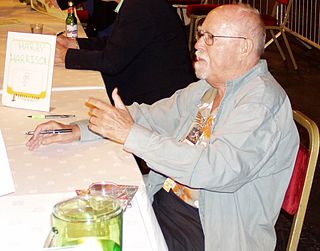
Harry Max Harrison was an American science fiction author, known mostly for his character The Stainless Steel Rat and for his novel Make Room! Make Room! (1966). The latter was the rough basis for the motion picture Soylent Green (1973). Long resident in both Ireland and the United Kingdom, Harrison was involved in the foundation of the Irish Science Fiction Association, and was, with Brian Aldiss, co-president of the Birmingham Science Fiction Group.
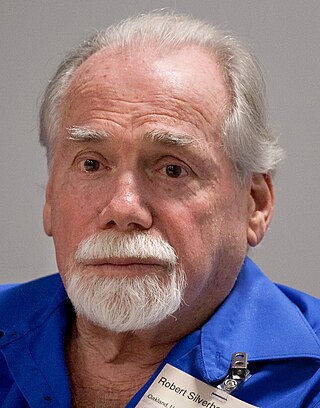
Robert Silverberg is an American author and editor, best known for writing science fiction. He is a multiple winner of both Hugo and Nebula Awards, a member of the Science Fiction and Fantasy Hall of Fame, and a Grand Master of SF. He has attended every Hugo Award ceremony since the inaugural event in 1953.
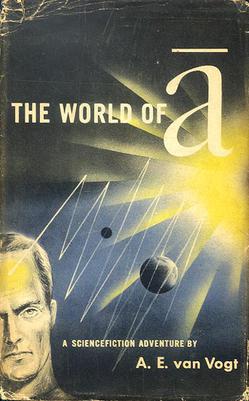
The World of Null-A, sometimes written The World of Ā, is a 1948 science fiction novel by Canadian-American writer A. E. van Vogt. It was originally published as a three-part serial in 1945 in Astounding Stories. It incorporates concepts from the General Semantics of Alfred Korzybski. The name Ā refers to non-Aristotelian logic.

"To Serve Man" is a science fiction short story by American writer Damon Knight. It first appeared in the November 1950 issue of Galaxy Science Fiction and has been reprinted a number of times, including in Frontiers in Space (1955), Far Out (1961), and The Best of Damon Knight (1976).
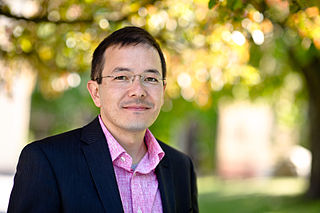
Shaun Tan is an Australian artist, writer and film maker. He won an Academy Award for The Lost Thing, a 2011 animated film adaptation of a 2000 picture book he wrote and illustrated. Other books he has written and illustrated include The Red Tree and The Arrival.

Far Out is a collection of 13 science fiction short stories by American writer Damon Knight. The stories were originally published between 1949 and 1960 in Galaxy Magazine, If Science Fiction and other science fiction magazines. There is an introduction by Anthony Boucher.
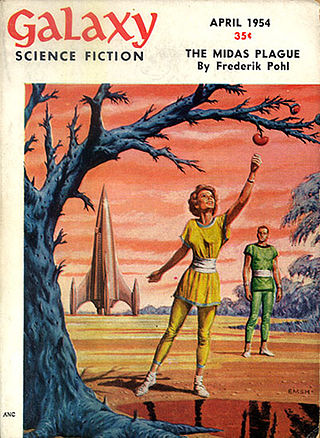
"Special Delivery" is a science fiction short story by American writer Damon Knight. It first appeared in the April 1954 issue of Galaxy Science Fiction and has been reprinted a number of times, in Operation Future (1955), Far Out (1961), and The Best of Damon Knight (1976).

"Dulcie and Decorum" is a science fiction short story by American writer Damon Knight. It first appeared in the March 1955 issue of Galaxy Science Fiction. In 1969 it was reprinted by Gollancz in the collection Off Centre.

In Search of Wonder: Essays on Modern Science Fiction is a collection of critical essays by American writer Damon Knight. Most of the material in the original version of the book was originally published between 1952 and 1955 in various science fiction magazines including Infinity Science Fiction, Original SF Stories, and Future SF. The essays were highly influential, and contributed to Knight's stature as the foremost critic of science fiction of his generation. The book also constitutes an informal record of the "Boom Years" of science fiction from 1950-1955.

Science Fiction Inventions is a reprint anthology of science fiction stories, edited by Damon Knight and published by Lancer Books as an original paperback in 1967.

Cosmic Stories and Stirring Science Stories were two American pulp science fiction magazines that published a total of seven issues in 1941 and 1942. Both Cosmic and Stirring were edited by Donald A. Wollheim and launched by the same publisher, appearing in alternate months. Wollheim had no budget at all for fiction, so he solicited stories from his friends among the Futurians, a group of young science fiction fans including James Blish and C. M. Kornbluth. Isaac Asimov contributed a story, but later insisted on payment after hearing that F. Orlin Tremaine, the editor of the competing science fiction magazine Comet, was irate at the idea of a magazine that might "siphon readership from magazines that paid", and thought that authors who contributed should be blacklisted. Kornbluth was the most prolific contributor, under several pseudonyms; one of his stories, "Thirteen O'Clock", published under the pseudonym "Cecil Corwin", was very successful, and helped to make his reputation in the field. The magazines ceased publication in late 1941, but Wollheim was able to find a publisher for one further issue of Stirring Science Stories in March 1942 before war restrictions forced it to close again.

Renee Gladman is a poet, novelist, essayist, and artist who describes herself as "preoccupied with crossings, thresholds, and geographies as they play out at the intersection of poetry, prose, drawing, and architecture." Her fourteen publications include the Ravicka cycle, crime novel Morelia, essay collection Calamities, and three books of drawings, beginning with Prose Architectures.

Midjourney is an artificial intelligence program created by a San Francisco-based independent research lab Midjourney, Inc. Midjourney generates images from natural language descriptions, called "prompts", similar to OpenAI's DALL-E and Stable Diffusion. It is speculated that the underlying technology is based on Stable Diffusion. The tool is currently in open beta, which it entered on July 12, 2022. The Midjourney team is led by David Holz, who co-founded Leap Motion. Holz told The Register in August 2022 that the company was already profitable. Users create artwork with Midjourney using Discord bot commands.



















